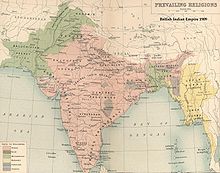The defeat of the last independent Nawab of Bengal at the Battle of Plassey ushered the rule of the British East India Company in 1757. The British displaced the ruling Muslim class of Bengal.[62] The Bengal Presidency was established in 1765, with Calcuttaas its capital. The Permanent Settlement created an oppressive feudal system. A number of deadly famines struck the region.
The Mutiny of 1857 was initiated in the Presidency of Bengal, with major revolts by the Bengal Army in Dacca, Calcutta and Chittagong.[63][64] Eastern Bengal witnessed numerous native rebellions, including the Faraizi Movement by Haji Shariatullah, the activities of Titumir, the Chittagong armoury raid and revolutionary formations such as the Anushilan Samiti. The Bengal Renaissance flowered as a result of educational and cultural institutions being established across the region, especially in East Bengal and the imperial colonial capital Calcutta. The Presidency of Bengal became the cradle of modern South Asian political and artistic expression. It included the notable contributions of Raja Ram Mohan Roy, Mir Mosharraf Hossain, Ishwar Chandra Vidyasagar, Sir Syed Ahmed Khan, Jagadish Chandra Bose, Khan Bahadur Ahsanullah, Rabindranath Tagore, Michael Madhusudan Dutt, Kazi Nazrul Islam and Begum Rokeya. Gopal Krishna Gokhle, the mentor of Mahatma Gandhi, remarked that "what Bengal thinks today, India thinks tomorrow".[65]
During British rule, East Bengal developed a plantation economy centred on the jute trade and tea production. Its share in world jute supply peaked in the early 20th century, at over 80%.[66] The Eastern Bengal Railway and the Assam Bengal Railway served as important trade routes, connecting the Port of Chittagong with a large hinterland.
As a result of growing demands for educational development in East Bengal, the British partitioned Bengal in 1905 and created the administrative division of Eastern Bengal and Assam. Based in Dacca, with Shillong as the summer capital and Chittagong as the chief port, the new province covered much of the northeastern subcontinent. The All India Muslim League was formed in Dacca in 1906 and emerged as the standard bearer of Muslims in British India. The partition of Bengal outraged nationalist Hindus and anti-British Muslims, leading to the Swadeshi movement by theIndian National Congress. The partition was annulled in 1911 after a long civil disobedience campaign by the Congress. The Indian Independence Movement enjoyed strong momentum in the Bengal region, including the constitutional struggle for the rights of Muslim minorities.
The Freedom of Intellect Movement thrived in the University of Dacca. By the 1930s, the Krishak Praja Party led by A. K. Fazlul Huq and the Swaraj Party led by C. R. Das came to represent the new Bengali middle class. Huq became thePrime Minister of Bengal in 1937. With the breakdown of Hindu-Muslim unity in the British Raj, Huq allied with the Muslim League to present the Lahore Resolution in 1940, which envisioned independent states in the eastern and northwestern subcontinent.
During the Second World War, the Japanese Air Force conducted air raids in Chittagong in 1942, displacing several thousand people.[67][68] The war-induced Bengal famine of 1943 claimed the lives of over a million people. Allied forceswere stationed in bases across East Bengal in support of the Burma Campaign. Axis-allied Subhash Chandra Bose also had a significant following in East Bengal.
The Muslim League formed a parliamentary government in Bengal in 1943, with Sir Khawaja Nazimuddin and later H. S. Suhrawardy as its premiers. At the Indian provincial elections, 1946, the decisive victory of the Bengal Muslim League set the course for the Partition of British India and the creation of the Dominion of Pakistan on 14 August 1947. Assamwas partitioned in order to allow Bengali-speaking Sylhet to join East Bengal. There was also an unsuccessful attempt to form a United Bengal. The Radcliffe Line divided Bengal on religious grounds, ceding Hindu-majority districts to the Indian dominion, and making Muslim-majority districts the eastern wing of Pakistan.



No comments:
Post a Comment